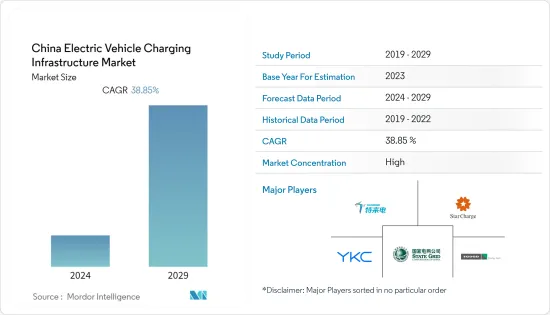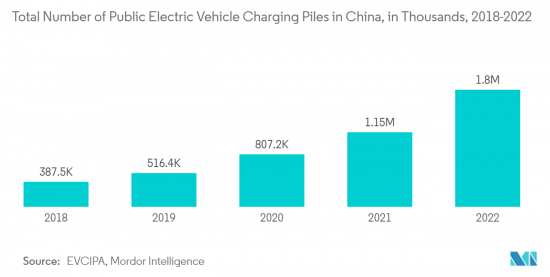PUBLISHER: Mordor Intelligence | PRODUCT CODE: 1406115

PUBLISHER: Mordor Intelligence | PRODUCT CODE: 1406115
China Electric Vehicle Charging Infrastructure - Market Share Analysis, Industry Trends & Statistics, Growth Forecasts 2024 - 2029

The China Electric Vehicle Charging Infrastructure Market is valued at USD 4.28 billion in the current year and is anticipated to reach a value of USD 22.09 billion within the next five years, registering a CAGR growth of 38.85% over the forecast period.
Growing adoption and sales of electric vehicles, as well as the enactment of laws, subsidies, and policies promoting the adoption of EVs, such as exemption from registration plate lotteries and access to restricted traffic areas, are some of the major factors driving the market's growth. Further, the government's increasing focus on developing an optimal electric vehicle charging infrastructure across the country to support the rising demand for EVs is aiding the growth of the electric vehicle charging infrastructure market in China. For instance,
Key Highlights
- In September 2023, the China Electric Vehicle Charging Infrastructure Promotion Alliance, abbreviated as EVCIPA, announced that approximately 61,000 public charging piles were added in the country in August 2023. It is an increase of 39.9% compared to the same period in 2022. Further, it was indicated that from September 2022 to August 2023, around 54,000 new piles were built on average each month in China, showcasing the rapid boost in developing the charging infrastructure in the country.
The collaboration between various OEMs, automotive manufacturers, and charging infrastructure developers is driving the market's growth. The EV charging infrastructure market in China drew investments from various capital holders, such as vehicle manufacturers, telecom operators, real estate companies, etc.
The increasing installation of private and public charging stations in China is propelling the growth of the market. It is estimated that as of the end of 2022, the total number of charging infrastructure in China reached 5.21 million units, reflecting a significant year-on-year increase of nearly 100%. It includes approximately 650,000 units of public charging infrastructure, resulting in a cumulative total of 1.8 million units, as well as around 1.9 million units of private charging infrastructure, reaching a cumulative total of over 3.4 million units. The government is also taking initiatives to improve the charging infrastructure in the country. For instance,
Key Highlights
- In September 2022, four Chinese ministries, including the Ministry of Transport (MOT), issued a plan to speed up the construction of highway charging infrastructure. The following two-phased objectives were established to meet the growing demand for electric vehicle (EV) charging and provide mobility convenience.
Thus, due to such factors, the market studied is expected to grow considerably during the forecast period.
China Electric Vehicle (EV) Charging Infrastructure Market Trends
Public Charging Stations are Expected to Gain Prominent Share in the Market During the Forecast Period
The Chinese electric vehicle charging infrastructure market is well supported by its battery electric vehicle market. It is backed by generous support from the government. China extended the incentives relating to the purchase of new energy vehicles (NEVs) till 2022.
The availability of public EV charging stations is critical in the purchase of electric vehicles worldwide. When purchasing an electric vehicle, public charging access to fast charging is regarded as a critical criterion. It is expected to boost revenue growth in the public charging segment. Due to the growing number of EV users, the Chinese government continues to install public charging stations at a rapid pace.
China implemented policies that encourage the use of electric vehicles by providing subsidies and lowering taxes. It also promotes the growth of EV manufacturers and related industries by providing grants or enacting preferential policies for EV-related businesses, allowing them to expand more quickly. A steady increase in economic growth, urbanization, and travel demand, combined with increased investments in electric mobility to contribute to energy storage and environmental sustainability, is expected to fuel the growth of the public charging station segment.
Buses, taxis, and electric light vehicles are the three major vehicle segments in China that make use of public charging stations. Apart from buses, which require specialized captive infrastructure, the majority of other vehicles require public fast charging. The rapid growth of electric vehicles and the country's pro-EV policies are expected to boost the market's growth in the future. For instance,
- According to the China Electric Vehicle Charging Infrastructure Promotion Alliance (EVCIPA), the total number of public electric vehicle charging piles in China touched 1,797 thousand as of 2022, expanding at a CAGR of 46.7% between 2018 and 2022.

Passenger Vehicles Across China to Gain Significance During the Forecast Period
China created the most public electric vehicle charging stations in the world as new energy vehicles gain traction in the world's largest car market.
China set a target of having 40% of vehicles sold in the country be EVs by 2030, indicating that many more passenger vehicles will need to be charged. The government hopes to include enough charging infrastructure in place by 2025 to meet the needs of more than 20 million cars. Currently, more than 70% of China's 810,000 public charging points are in densely populated coastal areas such as Guangdong and Shanghai. The National Development and Reform Commission and several other agencies issued guidelines calling for charging stations to be installed in all counties and villages as part of the government's "rural revitalization" effort.
China not only produces the majority of the world's EV batteries, but it is also forging ahead with EV development and manufacturing and selling them to the rest of the world. Domestically, the efforts to boost the EV industry are already paying off. It was estimated that between January 2023 and June 2023, more than 3.2 million new plug-in electric cars were registered in China. It is an increase of 38% compared to the same period in 2022.
Even as subsidies for EV purchases are phased out in recent years, sales skyrocketed. According to the International Energy Agency (IEA), 6 million battery electric cars were sold in China in 2022, accounting for nearly 22% of all new car sales for the year. After taking the growth into account, the Chinese government is also taking initiatives to build charging infrastructure in the country.
- In July 2022, the Chongqing Economic and Information Commission published a notice titled "Work Plan to Accelerate the Construction of EV Charging and Swapping Infrastructure in Chongqing." According to this notice, more than 240,000 EV chargers, including 30,000 public fast EV chargers, will be built by the end of 2025.
China Electric Vehicle (EV) Charging Infrastructure Industry Overview
The electric vehicle charging infrastructure market in China is fairly consolidated and highly competitive, with players such as TELD New Energy, Star Charge, YKC, State Grid Corporation of China, and TGood dominating the market. Other players in the market, including BYD, Tesla, Evking, and Southern Power Grid, among others, capture a smaller market share.
- In August 2023, Hyundai Motor Group announced its partnership with Chinese electric vehicle (EV) charging service information provider NaaS Technology for future EV charging business opportunities in China. Hyundai signed an initial pact with Naas at the Chinese firm's headquarters in Beijing to jointly develop customized EV charging services based on its connected services platform and NaaS charging infrastructure data.
- In April 2023, Tesla announced that the company would allow non-Tesla vehicles to be charged at Selected Superchargers installed by the company in China. Further, the company stated that 10 Supercharging stations across Beijing and Shanghai, as well as 120 destination charge points in 25 provinces and cities, will be available to non-Tesla electric vehicles beginning in April.
The electric vehicle charging infrastructure market in China will witness the integration of various incumbents and start-ups in the ecosystem. It is to capture the lucrative opportunity that this space provides during the forecast period.
Additional Benefits:
- The market estimate (ME) sheet in Excel format
- 3 months of analyst support
TABLE OF CONTENTS
1 INTRODUCTION
- 1.1 Study Assumptions
- 1.2 Scope of the Study
2 RESEARCH METHODOLOGY
3 EXECUTIVE SUMMARY
4 MARKET DYNAMICS
- 4.1 Market Drivers
- 4.1.1 Favorable Government Initiatives to Support the Growth of Electric Vehicle Charging Infrastructure
- 4.2 Market Restraints
- 4.2.1 Supply Shortages in Building Electric Vehicle Charging Stations
- 4.3 Industry Attractiveness - Porter's Five Forces Analysis
- 4.3.1 Bargaining Power of Suppliers
- 4.3.2 Bargaining Power of Buyers/Consumers
- 4.3.3 Threat of New Entrants
- 4.3.4 Threat of Substitute Products
- 4.3.5 Intensity of Competitive Rivalry
5 MARKET SEGMENTATION (Market Size in Value - USD)
- 5.1 By Charging Station Type
- 5.1.1 Alternating Current (AC) Charging Station
- 5.1.2 Direct Current (DC) Charging Station
- 5.2 By Vehicle Type
- 5.2.1 Passenger Vehicles
- 5.2.2 Commercial Vehicles
- 5.3 By User Application
- 5.3.1 Private Infrastructure
- 5.3.2 Public Infrastructure
6 COMPETITIVE LANDSCAPE
- 6.1 Vendor Market Share
- 6.2 Company Profiles*
- 6.2.1 TELD
- 6.2.2 Starcharge
- 6.2.3 YKC
- 6.2.4 State Grid Corporation of China
- 6.2.5 TGood
- 6.2.6 Evking
- 6.2.7 ShenZhen Carenergy Net
- 6.2.8 Southern Power Grid
- 6.2.9 Wancheng Wanchong
- 6.2.10 Hooenergy
- 6.2.11 EV Power
- 6.2.12 Eichong
- 6.2.13 SAIC Motor
- 6.2.14 Potevio
- 6.2.15 Winlands
7 MARKET OPPORTUNITIES AND FUTURE TRENDS
- 7.1 Rising Foreign Direct Investment to Foster the Growth of the Market




